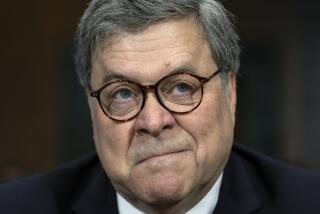Memo gives U.S. broad powers to kill Al Qaeda targets
WASHINGTON â In a newly revealed memo, the Obama administration claims authority to target and kill overseas Al Qaeda members, even American citizens, in broad terms that go beyond previous statements by the president and his top aides.
The administrationâs position has brought objections from some longtime critics. However, the response from Congress has been muted, reflecting the degree to which once-controversial practices in drone warfare have become mainstream after more than a decade of conflict.
The administrationâs legal justification for drone strikes, outlined in a Justice Department paper that became public Monday night, states that an âinformed, high-level officialâ can approve a strike against an Al Qaeda official, including an American citizen, even without evidence that the targeted person is planning a specific operation.â
âAn âimminentâ threat of violent attack against the United States does not require ⦠clear evidence that a specific attack on U.S. persons and interests will take place in the immediate future,â says the policy paper, which was provided to some members of Congress last summer and released initially by NBC News.
Although administration officials have said they would prefer to capture terrorists rather than kill them, the paper says a capture operation can be ruled out by a determination that the risk to American troops is too great. In almost every case, such operations have in fact been ruled out, U.S. officials say.
The paper appears to offer much more leeway than suggested by previous administration statements. In his most recent public comment on the issue, in September, Obama said the administration would authorize an attack in response to âa threat that is serious and not speculative.â
âIt has to be a situation in which we canât capture the individual before they move forward on some sort of operational plot against the United States,â he said in an interview with CNN.
The justification outlined in the policy paper has brought objections from some members of Congress. Sen. Ron Wyden (D-Ore.), who has long called on the administration to explain the legal rationale for killing American members of Al Qaeda, said it âleaves many of the most important questions about the presidentâs lethal authorities unanswered.â
But few lawmakers have joined his protests, and the administration official most closely connected to the formulation of the administrationâs policy on drone strikes, White House aide John Brennan, appears headed for a relatively easy confirmation as head of the CIA.
âIf anything, I would argue itâs a helpful thing, in that it removes some mystery and conspiracy theories,â a senior Democratic aide on the Senate Intelligence Committee, which is handling Brennanâs nomination, said of the policy paper.
The relative quiet reflects polls that show widespread public support for drone strikes as well as the greater political maneuvering room that a Democratic president has to pursue such policies. Whereas the U.S. criticized Israel for its targeted strikes on Palestinians during the 1990s, the Sept. 11, 2001, terrorist attacks brought a sea change in American policy on the matter, and the public has gone along. In addition, liberal Democrats who might be inclined to criticize the policy are reluctant to make life difficult for a popular president in their party.
A survey in June by the Pew Research Center found that 62% of Americans approved of drone strikes, but that pluralities or majorities in 19 other countries opposed them. A Washington Post-ABC News poll last February found that 83% of Americans approved of Obamaâs drone policy.
The Justice Department paper summarizes a classified 50-page memo prepared in 2010 by the Office of Legal Counsel to justify the subsequent targeting of U.S. citizen Anwar Awlaki. American officials said Awlaki was involved in several plots against the United States, including an attempt to bring down a jetliner over Detroit in 2009. He was killed in a U.S. drone strike in Yemen in September 2011.
Obama has greatly expanded lethal strikes against Al Qaeda-linked militants, mainly using aerial drones in Pakistan and Yemen. Both the CIA and the militaryâs Joint Special Operations Command run killing programs. The U.S. has carried out 385 strikes in Pakistan and Yemen since January 2009, according to the Long War Journal website, which tracks the attacks, compared with 46 during the eight years of the George W. Bush administration.
The United States is at war with Al Qaeda, the paper says, and therefore may kill its leaders as a matter of self-defense. Any American who becomes an operational leader of the group may be targeted.
But the broad authority asserted in the paper to kill Al Qaeda figures even when they have not been tied to an impending attack contrasts with the narrow way the drone strike program has been described by administration officials.
When Brennan gave a speech about drone strikes in April â the most detailed public comments about the covert program by any U.S. official to date â he said they were designed to neutralize a specific, identifiable threat.
âI am not referring to some hypothetical threat, the mere possibility that a member of Al Qaeda might try to attack us at some point in the future,â he said. âThe purpose of a strike against a particular individual is to stop him before he can carry out his attack and kill innocents. The purpose is to disrupt his plots and plans before they come to fruition.â
White House Press Secretary Jay Carney said Tuesday, âWe conduct those strikes because they are necessary to mitigate ongoing actual threats to stop plots, prevent future attacks and again save American lives.â
The policy paper makes it clear, however, that the U.S. doesnât need evidence tying a militant to a specific plot to mark him for death.
If an Al Qaeda member âhas recently been involved in activities posing an imminent threat of attack against the United States, and there is no evidence suggesting that he has renounced and abandoned such activities, that memberâs involvement in Al Qaedaâs continuing terrorist campaign ⦠would support the conclusion that the member poses an imminent threat,â the paper says.
The decision to order a lethal strike falls either to the president or his designee, an âinformed, high-level official,â in the words of the paper. No court or third party has a right to review it, the paper says.
âThe administrationâs concept of âimminent threatâ appears to require neither imminence nor a specific threat,â said C. Dixon Osburn, director of Human Rights First, a Washington activist group. âAccepted principles of international law require both.â
Times staff writer David G. Savage contributed to this report.
More to Read
Sign up for Essential California
The most important California stories and recommendations in your inbox every morning.
You may occasionally receive promotional content from the Los Angeles Times.











